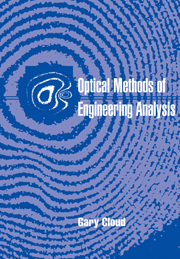Book contents
- Frontmatter
- Contents
- Acknowledgments
- 1 Introduction and orientation
- Part I Optics and interferometry
- Part II Photoelasticity
- Part III Geometrical moire
- Part IV Diffraction theory, optical processing, and moire
- Part V Moire interferometry
- Part VI Holographic interferometry
- 16 Holographic interferometry theory
- 17 Holographic interferometry methods
- Part VII Speckle methods
- Author index
- Subject index
16 - Holographic interferometry theory
Published online by Cambridge University Press: 12 January 2010
- Frontmatter
- Contents
- Acknowledgments
- 1 Introduction and orientation
- Part I Optics and interferometry
- Part II Photoelasticity
- Part III Geometrical moire
- Part IV Diffraction theory, optical processing, and moire
- Part V Moire interferometry
- Part VI Holographic interferometry
- 16 Holographic interferometry theory
- 17 Holographic interferometry methods
- Part VII Speckle methods
- Author index
- Subject index
Summary
This chapter begins the study of a topic that is very interesting for many reasons, technical and otherwise. Holography is a method for creating three-dimensional images without a lens, and it offers many intriguing possibilities. Holographic images are precise enough to be used in interferometry, and this idea leads to several powerful techniques for measurement in a broad range of application areas.
Orientation
Holography is a unique method of storing and regenerating all the amplitude and phase information contained in the light that is scattered from an illuminated body. Because all the information is reproduced, the regenerated object beam is, in the ideal case, indistinguishable from the original. Here is a technology that offers the possibility of perfect three-dimensional photography. Since it is possible to record the exact shape and position of a body in two different states, then it is also possible to compare the two records to obtain a precise measure of the movement or deformation. This measurement technique is called holographic interferometry.
Holography was invented by Dennis Gabor in about 1948 as a method for improving the usefulness of microscopy. It did not work very well, partly because the two beams created in holographic reconstruction, which form what are commonly thought of as the real and virtual images, ended up in line with one another in the arrangement necessitated by the apparatus then available. His theory was not, apparently, limited in this way; but the potential beauty and utility of the technique were masked by the problem with the two images.
- Type
- Chapter
- Information
- Optical Methods of Engineering Analysis , pp. 343 - 373Publisher: Cambridge University PressPrint publication year: 1995

